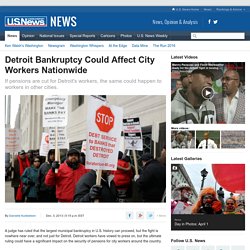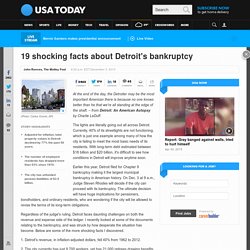

The Unions Didn't Bankrupt Detroit, But Great American Cars Did. Rickard Bindery: Folding is a core strength at Rickard Bindery where we provide advanced folding of all types for oversized, miniature, map, gate and specialty projects. Learn What Detroit’s Learned: Outsourcing Works Better A typical graphic arts job touches all these bases: design, photography, copy, layout, plates, press, bindery and mail.

A leading industry association has long been advising printing companies to diversify into as many of these areas as possible so that the “value-added” percentage of their business increases. If this outdated business model sounds familiar, it is. Value-added concepts have been rammed down our throats for decades. Let’s look at an unrelated industry: Automobiles.
Had there been no alternatives, U.S. consumers would have been forced to put up with these lousy, expensive products. What should the core competencies of a car company be – design, engineering, marketing and distribution? General Motors is still reeling from its misguided vertical integrated strategy – and still outsources only 45% of its vehicles today. Detroit Economy Improving as Big Three Make Comeback. DETROIT -- America had it bad during the Great Recession of 2008 and lingering months in the aftermath.

But the Detroit metro area had it worse -- much worse. Detroit's economy wasn't exactly in great standing before the housing bubble burst, before the automotive manufacturing that supports the community burst. It was already a case of haves, and have-nots. But when it all came crumbling down, with automakers slashing jobs and two filing for bankruptcy -- General Motors and Chrysler -- the shaky pedestal gave way. How Detroit's Automakers Went from Kings of the Road to Roadkill. Skip to comments.

How Detroit's Automakers Went from Kings of the Road to Roadkill Hillsdale College Imprimis | February 2009 Issue | Joseph B. White Posted on Wed 11 Mar 2009 11:27:56 AM CET by IbJensen JOSEPH B. WHITE is a senior editor in the Washington, D.C., bureau of The Wall Street Journal. The following is adapted from a speech delivered at Hillsdale College on January 26, 2009, at a seminar on the topic, "Cars and Trucks, Markets and Governments," co-sponsored by the Center for Constructive Alternatives and the Ludwig von Mises Lecture Series.
I'D LIKE to start by congratulating all of you. GM is an institution that survived in its early years the kind of management turbulence we've come to associate with particularly chaotic Internet startups. How does a juggernaut like this become the basket case that we see before us today? Detroit To Officially Exit Historic Bankruptcy. DETROIT, Dec 10 (Reuters) - Detroit will officially exit the biggest-ever U.S. municipal bankruptcy later on Wednesday, officials said, allowing Michigan’s largest city to start a new chapter with a lighter debt load.

The city, which filed for bankruptcy in July 2013, will shed about $7 billion of its $18 billion of debt and obligations. “We’re going to start fresh tomorrow and do the best we can to deliver the kind of services people deserve,” said Mayor Mike Duggan. Once a symbol of U.S. industrial might, Detroit fell on hard times after decades of population loss, rampant debt and financial mismanagement left it struggling to provide basic services to residents.
Later on Wednesday, payments to city creditors will be triggered under a debt adjustment plan confirmed by a U.S. Why did Detroit go bankrupt? Detroit's Bankruptcy: How Does It Affect You? - Stailey Insurance. Posted by William Cowie on Jul 26, 2013 photo: Kevin Bauman/100abandonedhouses.com You probably saw the headlines: “Detroit’s bankruptcy — biggest in history!”

And your reaction probably was something like, “Bummer for them. Please pass the ketchup.” You might want to rethink that attitude. Why? But first, a little background. Detroit files for bankruptcy protection. DETROIT -- The city of Detroit filed for Chapter 9 bankruptcy protection in federal court Thursday, laying the groundwork for a historic effort to bail out a city that is sinking under billions of dollars in debt and decades of mismanagement, population flight and loss of tax revenue.

The bankruptcy filing makes Detroit the largest city in U.S. history to do so. The filing begins a 30- to 90-day period that will determine whether the city is eligible for Chapter 9 protection and define how many claimants might compete for the limited settlement resources that Detroit has to offer. Detroit Bankruptcy Could Affect City Workers Nationwide. A judge has ruled that the largest municipal bankruptcy in U.S. history can proceed, but the fight is nowhere near over, and not just for Detroit.

Detroit workers have vowed to press on, but the ultimate ruling could have a significant impact on the security of pensions for city workers around the country. [READ: The Cities That Have Bounced Back the Most From the Recession] Federal Judge Stephen Rhodes on Tuesday determined that the city is insolvent and eligible for bankruptcy, meaning outstanding pension liabilities could be among the debts the city will be able to discharge.
Creditors had claimed the city could not cut accrued pension benefits, as the Michigan constitution expressly says state and city workers' pensions and retirement benefits "shall not be diminished or impaired. " However, the judge saw it differently. "Pension benefits are a contractual right and are not entitled to any heightened protection in a municipal bankruptcy," Rhodes said, as reported by the New York Times. City of Detroit files for bankruptcy. Detroit files for bankruptcy. In this July 17, 2013, aerial photo is the city of Detroit.

On Thursday, July 18, 2013, Detroit became the largest city in U.S. history to file for bankruptcy when State-appointed emergency manager Kevyn Orr asked a federal judge for municipal bankruptcy protection. AP Photo/Paul Sancya Updated 9:08 PM ET. 19 shocking facts about Detroit's bankruptcy. At the end of the day, the Detroiter may be the most important American there is because no one knows better than he that we're all standing at the edge of the shaft. – from Detroit: An American Autopsy by Charlie LeDuff.

The lights are literally going out all across Detroit. Currently, 40% of its streetlights are not functioning, which is just one example among many of how the city is failing to meet the most basic needs of its residents. With long-term debt estimated between $18 billion and $20 billion, it's difficult to see how conditions in Detroit will improve anytime soon.